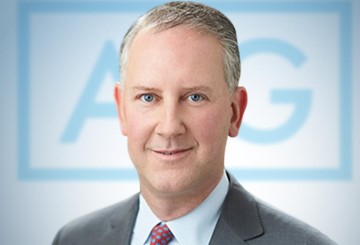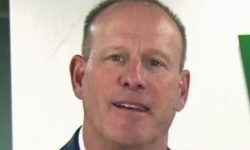Peter Zaffino (born 1967)[1] is an insurance industry executive.[2][3] He is CEO and president of AIG.[4][5]
Zaffino joined AIG in August 2017 as executive vice president and global chief operating officer.[6] He served as CEO of AIG's General Insurance business, the company's core property-casualty insurance unit, from September 2017 to August 2020.[7][8] On 1 January 2020, Zaffino was promoted to president of AIG and continued to serve as global COO.[9] On March 1, 2021, he became AIG's CEO.[4]
Prior to joining AIG, he was with Marsh & McLennan Companies (MMC)[2][3] for 16 years. With MMC he served as president and CEO of Guy Carpenter from 2008-2011, CEO of Marsh from 2011–2017, and chairman of MMC's Risk & Insurance Services segment from 2015–2017.[10]
American International Group, Inc., also known as AIG, is an American multinational finance and insurance corporation with operations in more than 80 countries and jurisdictions. As of December 31, 2016, AIG companies employed 56,400 people.[4] The company operates through three core businesses: General Insurance, Life & Retirement, and a standalone technology-enabled subsidiary.[5][6][7] General Insurance includes Commercial, Personal Insurance, U.S. and International field operations. Life & Retirement includes Group Retirement, Individual Retirement, Life, and Institutional Markets.[5][6][7]
AIG's corporate headquarters are in New York City and the company also has offices around the world. AIG serves 87% of the Fortune Global 500 and 83% of the Forbes 2000.[8] AIG was ranked 60th on the 2018 Fortune 500 list.[9] According to the 2016 Forbes Global 2000 list, AIG is the 87th largest public company in the world.[10] On December 31, 2017, AIG had $65.2 billion in shareholder equity.[11]
AIG was a central player in the financial crisis of 2008. It was bailed out by the federal government for $180 billion, and the government took control.[12] The Financial Crisis Inquiry Commission (FCIC) of the US government concluded AIG failed primarily because it sold massive amounts of insurance without hedging its investment. Its enormous sales of credit default swaps were "made without putting up initial collateral, setting aside capital reserves, or hedging its exposure — a profound failure in corporate governance, particularly its risk-management practices."[12] The US government sold off its shares after the crisis and completed the process in 2012.[13]




